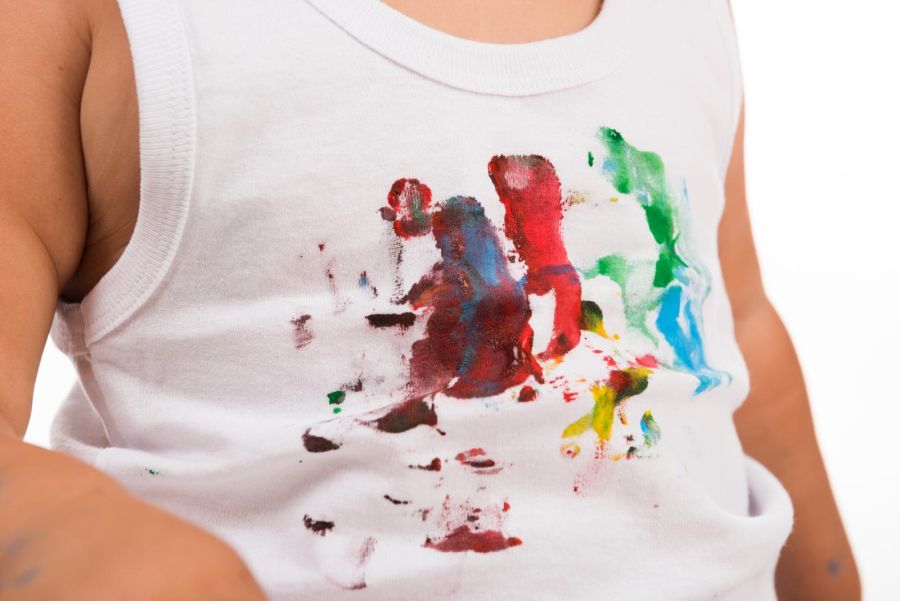Can You Get Outdoor Paint Out Of Clothes. What Pros Say
Ever spilled outdoor paint on your favorite outfit, only to dismiss it as ruined forever? You’re not alone! We will guide you through various strategies to remove tough outdoor paint stains from your clothes. No need to toss your stylish garments away, as we unveil tried and tested home remedies and expert tips in rescuing your beloved clothing items from their messy fate. Dive into this life-saving article to keep your wardrobe looking polished, no matter the circumstances!
Can you get outdoor paint out of clothes:
Outdoor paint stains on clothing can be removed with various methods. For water-based paints, rinse with cold water, soak in a dishwashing detergent mixture, and use ammonia for stubborn stains. For oil-based paints, act quickly and apply turpentine or white spirit before laundering. If all else fails, consider isopropyl alcohol, acetone, glycerin, or professional dry cleaning. Adhering to these methods and precautions can help salvage stained garments.

Discover foolproof methods to remove outdoor paint from your clothes without causing damage. Learn about safe and effective techniques for various fabric types, and explore precautionary measures to prevent future mishaps. Keep reading to salvage and revitalize your stained garments effortlessly.
Contents
- 1 Is it Possible to Remove Outdoor Paint Stains from Clothing?
- 2 Is it Possible to Remove Exterior Latex Paint Stains from Clothing?
- 3 Is the Presence of Paint Stains on Clothing Irreversible?
- 4 What is the Professional Method for Removing Outdoor Acrylic Paint from Clothing?
- 5 Is Rubbing Alcohol Effective in Removing Paint Stains from Clothing?
- 6 What is the Professional Method for Removing Non-Water-Based Paint from Clothing?
Is it Possible to Remove Outdoor Paint Stains from Clothing?
Outdoor paint stains on your cherished garments may evoke intense consternation. However, fret not, for an array of inventive and meticulous techniques will assist you in managing the conundrum at hand.
• Surmounting the Hurdle: A Step-by-Step Process
– Precautionary Measures: Laying the Groundwork
- Immediate Response: Act with alacrity to address the predicament, ensuring that the paint is still wet or at least hasn’t thoroughly ossified. Tarrying might result in an indelible blot.
- Assess the Damage: Gauge the type of paint that marred your clothes. It’s crucial to distinguish between water-based and oil-based paints, as varying solutions are mandated to eradicate each.
– The Water-Based Paint Conundrum: Strategies & Solutions
Allow us to venture forth into the realm of water-based paints and uncover efficacious methods to lift blemishes.
- Initial Rinse: Position the stained garment under a running tap with cold water. The pressure will extricate the paint from the threads but abstain from rubbing it lest you transplant the blemish to unsullied regions.
- Detergent Concoction: Prepare a potation containing liquid dishwashing detergent and cold water. Soak the sullied portion of your garment in the mixture and gently agitate it to facilitate further penetration.
- Inscrutable Stains – Enlisting Ammonia: For clandestine water-based paint marks, opt for an ammonia solution. However, be judicious in your application and never mingle it with chlorine bleach, as their amalgamation begets noxious fumes. Rinse thoroughly after application.
– The Oil-Based Paint Quandary: Tactics & Techniques
Facing tenacious oil-based paint smudges? Fear not, as the following stratagems will empower you to rid your garments of them.
- The Urgency Factor: If you delay addressing oil-based paint splotches, denaturing them can become a daunting task. Ergo, hastiness is imperative.
- Turpentine or White Spirit Intervention: Dab a clean cloth with turpentine or white spirit, gingerly applying it to the besmirched area. These solvents will disintegrate the oil content, thereby loosening the paint. Remember to always test the solvent on a discreet portion of the fabric before proceeding further.
- Laundering the Garment: Presuming the stain has abated significantly, proceed to launder the garment following the manufacturer’s guidelines. Utilize a robust detergent and opt for the warmest appropriate water temperature.
• A Cogent Contingency Plan: When All Else Fails
Should the aforementioned methods falter, there is still hope for the beleaguered as we present alternative decontamination techniques.
- Isopropyl Alcohol or Acetone Intervention: For obstinate smears, resort to isopropyl alcohol or acetone, dabbing your cloth with the solvent and exercising meticulous caution to avert damage.
- Harnessing the Power of Glycerin: A glycerin-based solution can help disengage unyielding stains by breaking down thorny components and reinvigorating your enfeebled garment.
- A Last Resort – Dry Cleaning: When all other avenues have been exhausted, contemplate depositing your garment at a trusted dry cleaner, entrusting them with the task of rescuing your sullied attire.
• Conclusion: A Beacon of Hope for the Stain-Stricken
Embarking on this intricate journey of revivifying paint-blighted clothes, we’ve unraveled diverse stratagems for contending with both water-based and oil-based paint predicaments.
By adhering to these meticulously delineated methods and heeding cautious measures, you can salvage your treasured garments from the perils of outdoor paint.
Step | Instructions |
|---|---|
1 | Act quickly: The sooner you address the paint stain, the higher the chance of removing it successfully. |
2 | Identify the paint type: Check the paint can to determine if it’s water-based or oil-based. Different treatments are required for each type. |
3 | Scrape off excess paint: Gently use a spoon or dull knife to remove as much excess paint as possible without spreading the stain. |
4A | If water-based paint, rinse with cold water: Run the stained area under cold water to flush out as much paint as possible. |
4B | If oil-based paint, use paint thinner or turpentine: Apply a small amount to a cloth or cotton ball and gently dab the stain. Test on an inconspicuous area of the fabric first to ensure it doesn’t cause further damage. |
5 | Apply stain remover: Apply a pre-treatment stain remover or a small amount of liquid detergent to the affected area, following the product instructions. Allow it to sit for a few minutes. |
6 | Wash the garment: Wash the clothing in cold water with regular detergent. Check the care label for proper washing instructions. |
7 | Inspect the stain: After washing, inspect the clothing for any remaining paint. If the stain persists, repeat the treatment process before drying the garment. |
8 | Dry the garment: If the stain has been removed, dry the clothing according to the care label instructions. |
Is it Possible to Remove Exterior Latex Paint Stains from Clothing?
• The Incessant Struggle with Paint Stains
Have you ever found yourself entrenched in a painting project only to have a seemingly permanent reminder of your labors as you discover a rogue stain on your favorite shirt?
Fear not, as we delve into the labyrinth of paint removal methods to address the question: does exterior latex paint come out of clothes?
• The Genesis of Latex Paint
Before we tackle the conundrum itself, we must first apprehend the nature of exterior latex paint. A non-toxic amalgamation of acrylic resins and polymers, latex paint, distinguishes itself from its oil-based peers due to its quick drying times, access to a cornucopia of color options, and ease of application.
In addition, it is prized for its resistance to the elements, be it inclement weather or scorching sun. However, does the very same resistance render it impervious to removal from clothing?
• Procedure One: Swift Intervention
A pivotal factor in latex paint removal is undoubtedly the temporal aspect – the moment you discern an errant droplet adorning your attire, initiate the cleansing process.
– Supplies:
- Cold water
- Mild detergent
- Soft-bristle toothbrush
- White cloth or paper towel
– Method
- Begin by blotting the excess paint using a clean white cloth or paper towel, carefully avoiding the temptation to rub the stain, as this may exacerbate the issue.
- Employ cold water to rinse the stain from the reverse side in a relentless stream, driving the paint away from the fabric.
- Apply a modest amount of mild detergent directly to the soiled area and gently agitate it with a soft-bristle toothbrush in a circular motion.
- Upon the cessation of the toothbrush treatment, rinse the garment thoroughly under cold water.
- Inspect the once-marred fabric – should the stain persist, repeat steps 3 and 4. If a triumphant victory has been secured, launder the apparel in accordance with its care label.
• Procedure Two: The Emancipation of Dry Paint Stains
In the unfortunate event that a latex paint stain has adhered to your garment for an extended period, adhere to the following method with steadfast determination.
– Supplies
- Plastic scraper or butter knife
- Soft-bristle toothbrush
- Rubbing alcohol
- Cotton swab or sponge
- Mild detergent
– Method
- Employ a plastic scraper or butter knife to carefully excise the dried paint, not inflicting further damage on the fabric.
- Dampen a soft-bristle toothbrush and gently abrade the residual paint using a circular motion to sever the remaining bonds.
- Saturate a cotton swab or sponge with rubbing alcohol before carefully applying directly onto the afflicted area. Allow the alcohol to permeate the paint for several minutes.
- Utilize the toothbrush to administer another gentle scrubbing with a circular motion, subsequently rinsing the area thoroughly with cold water.
- If the stain persists, integrate the use of mild detergent, as outlined in Procedure One, ensuring that the garment is ultimately laundered according to care instructions.
• Coda: The Efficacy of Paint Removal Endeavors
In conclusion, within the precipice of paint removal possibilities lies the answer: yes, exterior latex paint can, indeed, be extricated from clothing. Diligence, accurate technique, and attentiveness to detail contribute to ensuring your garments remain unscathed in the face of painting endeavors.
By adhering to the aforementioned methods and demonstrating an unwavering commitment to stain removal, you can conquer the seemingly indomitable foe that is exterior latex paint.
Is the Presence of Paint Stains on Clothing Irreversible?
Embarking on an artistic journey or tackling an interior makeover can inadvertently result in splatters and splotches on our garments. One ponderous question inevitably arises: “Are paint stains on clothes permanent?”
Delve into this treatise to discover the veracity of paint stain permanence and acquire salient knowledge on the intricacies of expeditious paint removal.
• A Tapestry of Tints: Deciphering Varieties of Paint
The permanence of paint stains on clothes pivots on the type of paint and its chemical composition. Outlined below are the principal categories of paint and their defining characteristics.
– Water-Based Paints: A Banquet of Fluidity
A cornucopia of vibrant hues can be achieved through water-based paints, which comprise latex and acrylic varieties. These paints have a propensity for being easier to remove from fabrics, as their fundamental solvents are predominantly water.
However, reactions with air and materials may cause them to amalgamate, presenting complexities in expunging them.
– Oil-Based Paints: The Realm of Ardor and Gloss
An apotheosis of luminosity, oil-based paints are recognized for their lustrous sheen and steadfast adhesion. Yet, these beguiling attributes render oil-based paint stains a formidable adversary as they often prove recalcitrant in relinquishing their grip on fabrics.
– Enamel Paints: The Patina of Durability
Renowned for their enduring performance and protective layers, enamel paints present themselves as Pandora’s box of challenges when it comes to fabric stains. Quite often, their stubborn nature and unyielding resilience make them an arduous obstacle to surmount during clothing stain conquests.
• A Menagerie of Defenses: Remedial Techniques for Different Paint Stains
Contrary to fearsome belief, paint stains on clothes are predominantly not immutable. By employing precision and deliberate measures, fabric integrity can be preserved.
– Conquering Water-Based Paint Stains: A Symphony of Remedies
These approaches, apt for situations where the paint is still wet, maximize the chances of rescuing one’s garments:
- Expeditious action: Time, the most capricious ally, demands swift intervention. Gently blot the afflicted area with an absorbent material such as a paper towel or napkin to curtail paint dispersion.
- Running water: A cascade of potable water can be strategically directed towards the reverse side of the textile, impelling the paint to retreat from its insidious infiltration.
- Detergent diplomacy: A gallant concoction of mild detergent and water can be deployed to further dislodge paint residues. Gentle dabbing with a soft implement enhances the potency of this procedure.
– Deflating Oil-Based Paint Stains: The Trepidation of Turpentine
As a paint solvent, turpentine is indispensable when confronting indomitable paint stains. In alliance with the aforementioned steps for water-based paint removal, this elixir can promote successful stain annihilation.
Exercise caution in the application of turpentine, particularly when attending to delicate fabrics, to mitigate potential damage. Additionally, adequate ventilation is non-negotiable to maintain safety during the turpentine skirmish.
– Dismantling Enamel Paint Stains: The Fickle Battle of Fortitude
Summon all your mettle in the face of enamel paint stains. Despite the daunting nature of these stains, they can capitulate to the persistent coaxing of paint thinner or a specialized enamel paint remover. Precautions similar to those for oil-based paint can be judiciously adopted to prevent fabric degradation.
Observe closely and continually with a keen eye for detail in order to halt the unstinting excavation of the paint thinners when they have fulfilled their purpose.
• In Celebration of Triumph: Dispelling the Myth of Permanence
Having navigated the labyrinthine territory of paint stains with sagacity, our initial question is aptly addressed. Indeed, paint stains on clothes are not an irrevocable sentence of ruin.
Through astute measures, intrepid tenacity, and timely response, the tyranny of paint stains can be vanquished, returning our cherished apparel to its original glory.
What is the Professional Method for Removing Outdoor Acrylic Paint from Clothing?
• Identifying the Stain: Acrylic vs. Concrete
Before delving into the eradication process, let us first discern between two common types of outdoor paint: acrylic and concrete.
Acrylic paint, a water-based medium typically found in art supplies, adheres to fabric due to the plastic polymer. Conversely, concrete paint poses a challenge with its solvent-based counterparts, rendering them tenacious when coming in contact with the fabric.
• The Immediate Response: Tackle it Promptly
Acting promptly when faced with acrylic paint stains is the pinnacle of success in mitigating potential fabric damage. A systematic and expeditious countermeasure allows for increased hopes of full stain removal.
– Step 1: Sponge it Away
When dealing with fresh paint spills, commence by using a tissue or cloth to sponge the excess paint. Employ a blotting motion rather than rubbing, thus circumventing the spread of the stain to other fibers.
– Step 2: Cold Water Flux
After sponging the excess paint, run cold water on the stain from the back of the fabric. This action disallows paint penetration into the textile, increasing the probability of successful removal.
• The Thorough Cleanse: Confronting Stubborn Stains
Should the immediate response method fail to provide satiation or when confronted with a dried, stubborn acrylic paint stain, undertake the following comprehensive plan of action, embracing the adversary with fortitude.
– Step 3: Amalgamate a Potent Concoction
Implementing an efficacious concoction requires combining equal amounts of warm water, white vinegar, and liquid dish soap. Enzyme-laden detergent serves as an adequate substitution for liquid dish soap.
– Step 4: Soak, Swirl, and Settle
Submerge the blemished garment into the concoction, ensuring the solution covers the fabric entirely. Swirl the piece within the solution, allowing it to settle for about an hour.
– Step 5: Impassioned Agitation
Once the garment has soaked for a sufficient duration, initiate the washing process. Rub the stain gently while remaining vigilant in observing any acrylic paint remnants. For indomitable spots, utilize a soft-bristled brush, further pulverizing the paint particles.
– Step 6: Culminate in Laundering
Examine the fabric for any lingering acrylic particles post-agitation. If the stain persists, repeat Steps 4 and 5. Upon achieving a satisfactory outcome, launder the piece according to the care instructions.
• Remedial Measures: Responding to Paint Spatters
In the eventuality of an accidental paint spatter, react instantaneously with the ensuing remedies.
– Step 7: Freezing Technique
Adopt the freezing strategy by placing the paint-spattered textile into a plastic bag and thereafter into the freezer. Allow the item to rest for an hour, and upon solidification, scrape away the frozen paint using a blunt-edged apparatus.
– Step 8: Irony in Heat
An unlikely approach, utilizing an iron to remove spatters, involves placing a sheet of wax paper atop the stain before employing heat. This technique promotes a transfer of paint from fabric to wax paper while ironing. Heed caution when determining if this method is suitable for a particular type of fabric.
• Conclusion
By following the aforementioned structured course of action, one maximizes the potential for successful acrylic paint elimination from garments.
Swift and resolute responses, paired with thorough cleansing methods, embody the essence of triumph over such wardrobe assailants, thus restoring the garment to its pristine condition.
Step | Action |
|---|---|
1 | Remove excess paint: Gently scrape off any excess wet paint using a spoon or the edge of a credit card. |
2 | Rinse with cold water: Run the stained area under cold water to flush out as much paint as possible. |
3 | Apply a stain remover: Apply a commercial stain remover or a mixture of dish soap and water to the stained area. Gently rub the solution into the fabric with a soft cloth or sponge. |
4 | Let it soak: Allow the stain remover to sit on the stain for 15-20 minutes, giving it time to break down the paint. |
5 | Blot the stain: Use a clean cloth or paper towel to blot the stain, lifting as much of the paint as possible. Do not rub, as this can further embed the paint into the fabric. |
6 | Rinse and repeat: Rinse the stained area under cold water again. If the stain persists, repeat steps 3-5 as needed. |
7 | Wash the garment: When the stain has been mostly or completely removed, wash the garment as usual, following the care label instructions. Inspect the garment after washing to ensure the stain is gone before drying, as heat can set the stain. |
Is Rubbing Alcohol Effective in Removing Paint Stains from Clothing?
A vexing debacle confronting many individuals is the inadvertent stains of paint encountered on their cherished garments. Fear not, for herein lies the elucidation of utilizing rubbing alcohol in surmounting this predicament!
• The Enigmatic Essence of Rubbing Alcohol
Firstly, let us delve into the mystifying properties of this unassuming household item. Rubbing alcohol, more scientifically known as isopropyl alcohol, exhibits powerful solvent characteristics, dissolving an array of substances, from inks to adhesive residues. Thus, its aptitude for paint removal is no surprise.
– Isopropyl Alcohol Varieties
Lest we forget, isopropyl alcohol is available in diverse concentrations. A higher potency, such as 99% or 91%, is more efficacious in paint removal. However, exercise caution, as an ardent concentration may also prove deleterious to fabrics.
• Paint: The Insidious Adversary
Confronting this tenacious foe, one must comprehend its diverse types before launching into action. The most commonly encountered culprits are:
- Water-based paints
- Oil-based paints
- Acrylic paints
Understanding the paint’s nature will dictate the most effective countermeasure.
– Water-Based and Oil-Based Paints: The Preliminary Onslaught
For the lesser obstinate water-based and oil-based paints, rubbing alcohol is a formidable ally. Begin by applying a diminutive amount to a clean cloth or cotton ball, and dabbing the afflicted area gently.
Repeat the process until the stain is vanquished. Then launder the garment according to its care instructions.
– Acrylic Paints: A Relentless Foe
The arduous task of removing acrylic paint necessitates a more cunning stratagem. Since acrylic paint dries swiftly, forging a resilient bond with the fabric, swift action is paramount.
Step 1: Diligent Dilution
Immediately dilute the lamentable stain with copious amounts of water. This assiduous act impedes the formation of an unyielding bond, increasing the likelihood of a triumphant outcome.
Step 2: Sponging Sojourn
With the paint sufficiently dampened, gently sponge the area with a soft, saturated cloth or sponge, striving to extricate excess paint. Refrain from rubbing or agitation, as that may exacerbate the predicament.
Step 3: Alcohol Assault
In this decisive maneuver, dab the soiled region liberally with rubbing alcohol. Exhibit patience, allowing the alcohol to penetrate and eviscerate the paint, disrupting the bond to the fabric.
Step 4: Laundering the Fallen Adversary
Once the paint has loosened sufficiently, launder the garment in accordance with its care guidelines. Upon extraction, inspect the battlefield for remnants of the vanquished foe. If necessary, repeat the prior steps.
– Cautionary Caveats
As with any formidable weapon, rubbing alcohol warrants caution in its deployment. With untested fabrics, endeavor a small-scale trial in an inconspicuous locale to assess compatibility. Fabrics of a delicate or fragile nature may warrant professional intervention.
• In Conclusion: Rubbing Alcohol – Can It Remove Paint from Clothes?
The discourse has elucidated the efficacy of rubbing alcohol in obliterating paint from garments, provided astute application and swift action are undertaken. The path to victory is contingent on the paint type, fabric, and concentration of rubbing alcohol.
Be mindful of the aforementioned caveats, and success shall smile upon your endeavors!
What is the Professional Method for Removing Non-Water-Based Paint from Clothing?
When you come across a significant spill of non-water-based paint on your clothes, it can seem like an insurmountable challenge. Yet, fret not, as multiple remedies can help you reclaim the splendor of your stained apparel.
• 1. Immediacy: The Friend of the Paint-Stain Combatant
The perennial adage, “time is of the essence,” rings true when confronting non-water-based paint on clothes. The quicker you attend to the blemish, the greater the chances of successfully eliminating it.
– Prepaint Proliferation Preemption Technique
Ready yourself by donning gear that can thwart paint invasions, such as aprons, coveralls, or other protective vestments. This pre-emptive maneuver ensures your cherished items remain unsullied.
– The Knack for Nifty Napkin Deployment
Promptly blot away excess paint using a paper towel, terry cloth, or an expendable piece of fabric. Evading the opportunity for the paint to seep deeper into your clothing is integral to a victorious eradication.
• 2. Prowess with Paint-Vanishing Preparations
To conquer the territory of paint expulsion, familiarity with different solutions is key. Each comes with its own distinctive approach and, with judicious application, exorcises the bane of stubborn paint stains.
– Solvent Approach: The Alchemical Antidote
Depending on the nature of the non-water-based paint, you may need specific solvents to dissolve its formidable defense. Gently dab some solvent (such as turpentine, acetone, or paint thinner) onto a cotton ball and then press it against the obdurate blotch.
Practice caution while employing these potent potions, as improper usage can exacerbate the situation, thus leading to garment ruin.
Cautionary Note: Ensure compatibility between the fabric and your chosen solvent. To avoid disastrous outcomes, perform a patch test on a concealed section of the clothing first.
– The Enzymatic Expulsion Crusade
Enzymatic cleaners prove highly efficacious in annihilating unyielding paint stains. Start by covering the culprit with a generous layer of enzyme cleaner (or paste made by combining an enzyme-based laundry detergent and water), and rubbing it in gently.
Allow the solution to penetrate for approximately 30 minutes. Finally, proceed to launder the fabric according to its care instruction.
– Freezer Magic: The Cryogenic Assault
Some varietals of non-water-based paint (such as latex) can be subjected to a unique technique. By employing cryogenic principles, you can freeze your way out of the predicament. Carefully place the sullied garment into a plastic bag, ensuring the blemish faces upwards.
Seal it, and lay it flat in the freezer with the stain on top. Give it about six hours to freeze solid. Then, extract the item from the frosty depths and promptly commence to pluck off the frozen paint globules, proceeding cautiously to avoid damaging the fibers.
• 3. The Post-Intervention Aftercare Crusade
After enacting one or a combination of techniques mentioned above, tenderly hand-wash the apparel with mild detergent to expunge the final vestiges of the paint incursion.
Rinse thoroughly, ensuring no hint remains. Once satisfied with the cleansing, air-dry the rejuvenated article of clothing, liberated from the clutches of non-water-based paint.
In conclusion, the road to refreshing your treasured textiles may prove daunting, yet with expeditious action, the masterful use of potent formulas, and diligent aftercare, resplendent garments will be yours to bask in once again.
Step | Description |
|---|---|
1 | Remove excess paint: Gently scrape off as much paint as possible using a spoon or butter knife. |
2 | Identify the type of paint: Check the paint can or the manufacturer’s website for information on the best solvent to use for clean-up. |
3 | Test the solvent: Apply a small amount of solvent to an inconspicuous area of the garment to ensure it doesn’t damage the fabric. |
4 | Apply the solvent: Dampen a cloth or cotton ball with the solvent and gently dab the stained area, working from the outside in to prevent spreading the stain. |
5 | Rinse the garment: Carefully rinse the treated area with cold water to remove the paint and solvent. |
6 | Repeat if necessary: If the stain persists, repeat steps 4 and 5 until the paint is completely removed. |
7 | Wash the garment: Launder the clothing according to the care label instructions, but avoid using the dryer until the stain is completely gone. |







